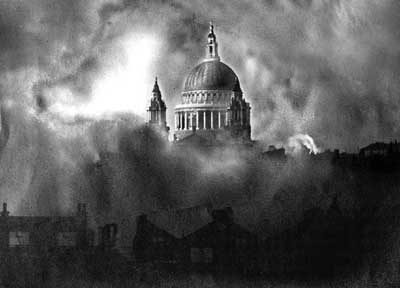
1939 January The British Government had brought in the ARP (Air Raid Precautions)
Act, which made councils responsible for setting up safety
measures such as the blackout, air-raid
warnings and shelters to protect civilians. 28 August London schoolchildren went back to school to take part in an
evacuation rehearsal. 31 August The order was given for the evacuation plans to be put into operation,
and during the next four days nearly 1.9 million people were evacuated,
including almost 1.5 million children, over half of whom
were in school parties. From the London area alone 376,652 children and their teachers,
275,895 pre-school children and their mothers, 3,577 expectant
mothers were transported out of the capital. 1 September Hitler, Nazi leader of Germany, invaded Poland. On the same day the National Registration Act was passed in
Parliament, requiring all citizens of the country to register their details. 3 September France and Britain (the Allies) declared war on Germany.
British troops landed in France. 1940 January Introduction of rationing Germany invaded Norway and Denmark and then moved into
Holland, Belgium, France and Luxembourg. British troops were
forced to retreat across the Channel from Dunkirk. 8 August
The Battle of Britain began with Hitler concentrated the attacks of
the Luftwaffe (Germany Air Force) on knocking out Britain's air
bases and destroying the RAF, ready to invade. September
Germany launched heavy bombing raids then began the Blitz,
bombing London and other civilian targets. The aim was to
target factories connected with the war effort and to bomb
civilians to destroy the morale of the country.Barrage balloons
filled with gas were raised high in the sky,
to stop low-flying enemy planes. 1941 Hitler stopped bombing raids on Britain and began
attacking the Soviet Union. The USA joined the Allies after the Japanese bombed
Pearl Harbour naval base in Hawaii. 1942 US troops arrived in Britain. The Luftwaffe began the Beadeker Raids, named after a series of
Germany guidebooks, and aimed at Britain's historic cathedral
towns and cities that had no military target. 1944 6 June D-Day (Normandy Landings): Allied troops landed all along
the coast of Normandy, in northern France, and was soon pushing
slowly but surely inland and moved into Germany. Hitler launched the flying bomb - known as the V-1, commonly
called 'doodlebugs' or 'buzz bombs'. This was a pilotless plane,
loaded with explosive and launched from the French coast with
enough fuel to bring it over London. The engine would then cut out
and the plane would nose-dive to the ground and explode on impact. The V1 was followed by the more dangerous V-2 which was a
supersonic rocket which made not sound until it landed and
detonated its ton of explosive. 1945 7 May Germany surrendered to the Allies. 8 May VE Day (Victory in Europe) 14 August Japan surrendered. 15 August VJ Day (Victory in Japan) ended the war.

